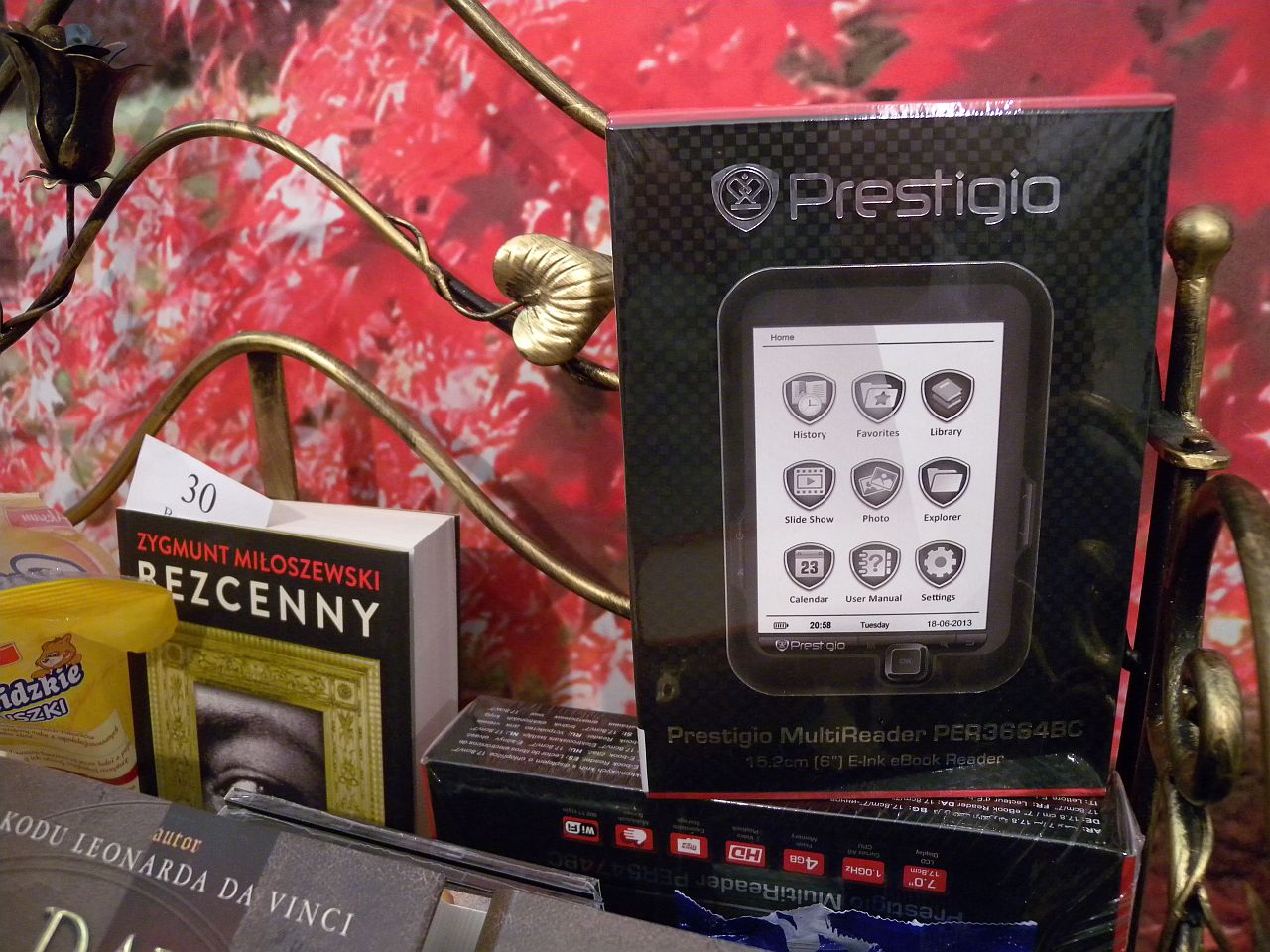17 Targi Książki w Krakowie zakończyły się wczoraj. Czas na podsumowanie z punktu widzenia książek elektronicznych.
W tym roku obecność e-booków i czytników była zaskakująco mała. Poprzednie lata przyzwyczaiły zwiedzających do ciekawych akcji i wielu atrakcji. Były to spore stoiska empiku czy choćby opisywane przeze mnie w zeszłym roku spotkania i quizy organizowane przez Virtualo. Również inni wystawcy pokazywali czytniki oraz odbywała się prezentacja możliwości tych urządzeń. W zeszłym roku publio.pl wsławiło się zakrojoną na szeroką skalę akcją rozdawania e-booków za książki papierowe przyniesione na Targi. Ale to przeszłość.
Rok 2013 pozostanie w pamięci osób zainteresowanych książkami elektronicznymi pod znakiem spadku zainteresowania wystawców związanych z rynkiem e-booków. Ogólnie nie dopisali ani producenci czytników ani księgarnie, choć na szczęście było kilka chlubnych wyjątków.
Woblink
Bezsprzecznie najciekawiej zaprezentował się Woblink. Po raz kolejny stoisko wyróżniało się nie tylko wizualnie ale i samym pomysłem. W tym roku załoga księgarni zachęcała do czytania e-booków pod hasłem zabawy w port lotniczy. „Pasażerowie” mogli się „odprawić” i „odlecieć” z bezpłatnym e-bookiem jak i pomysłowymi gadżetami na przykład w postaci przypinek z różnorodnymi hasłami reklamującymi książki elektroniczne. W różnych dniach i o różnych porach widziałem stoisko Woblinka i ani razu nie brakowało tam „pasażerów”. Pomimo panującej na sali duchoty i niekończącego się strumienia osób zwiedzających Targi, z twarzy „stewardes” nie znikał uśmiech i życzliwość dla klientów. Stewardzi dzielnie starali się im dorównać.

Chętni do odprawy na woblink.com
Jedyne, czego zabrakło na stoisku, to kilku osób, które mógłby w natłoku chętnych tłumaczyć na czym polega czytanie na czytniku czy nawet tablecie. Co prawda gdzieś w tle rozmów z klientami pojawiał się jeden Kobo i jeden tablet, ale sądzę, że wiele osób minęło stoisko Woblinka wciąż nie rozumiejąc o co w tym wszystkim chodzi.

Ostatnia papierowa książka dla przyszłych klientów Woblinka
Ale czy to początkujący czy tacy „podróżnicy” jak ja, u których na wirtualnej półce był już pierwszy a nawet drugi tom „Kacpra Ryxa”, nie odeszli z pustymi wirtualnymi półkami.
Nexto
Kolejną firmą, która zaznaczyła swoją obecność było Nexto. Odbyło się to w postaci spotkania w sali seminaryjne, które przebiegło pod hasłem „Czym jest rynek ebooków?”. Spotkanie zostało bardzo dobrze przygotowane i poprowadzone głównie przez Bartosza Roszkowskiego. Przedstawiony został rozwój rynku książek elektronicznych. Zwrócono uwagę na światową dominację firm z Ameryki Północnej (Amazon, Barnes & Noble, Kobo) oraz brak wyraźnego lidera w Polsce. Polski rynek stoi na razie pod znakiem konkurowania sześciu najważniejszych firm: Woblinka, Nexto, Publio, Legimi, Ebookpointu oraz Virtualo. Za większością stoją firmy zajmujące się do tej pory dość tradycyjną działalnością (wydawcy i dystrybutorzy książek czy gazet). W prognozach wskazano na zwiększanie się dystrybucji treści kanałami cyfrowymi oraz dążenie dostawców do modelu abonamentowego również w udostępnianiu e-booków na wzór abonamentów na muzykę. Zauważono też wciąż spore ograniczenia formatów plików najpowszechniejszych w e-bookach.

Prezentacja nexto.pl
Nexto zaznaczyło też swoją obecność na Targach w postaci udostępnienia pięciu wybranych e-booków ze swojej oferty. Odwiedzający mogli otrzymać kod i pobrać „Metro 2033”, „Punkt wyjścia”, „Halloween”, „Efemerydę” oraz „Zadzwoń, jak cię zabiją”.
Wydaje.pl
Kinga Kasperek, przedstawicielka z firmy z Katowic, starała się wyjaśnić korzyści płynące z self-publishingu jak i korzystania z wydaje.pl. Półgodzinna prezentacja na szczęście dotyczyła nie tylko założeń ale i pokazane zostały przykłady czterech autorów związanych z wydaje.pl. Serwis chce się wyróżniać od innych tego typu, wspieraniem autorów w sposób dostosowany do polskich realiów.

Prezentacja wydaje.pl
Ktoś jeszcze?
Warto zapewne jeszcze zauważyć akcję Publio. W tym roku publio.pl zdecydowało się również na wsparcie akcji „Książka za książkę”. Jednak teraz ograniczyło się to do jednego e-booka do wyboru z trzech zaproponowanych przez księgarnię.
Swoją obecność zaznaczył też Ebookpoint, który na bazie kodu z paragonu z kasy do każdej książki papierowej dodawał wersję elektroniczną. Nie pomyślano jednak o bibliotekach. Kiedy chciałem wziąć książkę na fakturę, okazało się, że nie będzie ona zawierać wspomnianego kodu. Zrezygnowałem tym bardziej, że ceny były identyczne z tymi w księgarni internetowej.
Gandalf jak zwykle kusił spotkaniami autorskimi ale i loterią, w której można było wygrać czytnik książek marki Prestigio. Ja sam wylosowałem bon zakupowy (który mam nadzieję wykorzystać na e-booki). Niestety, póki co wpisywany na stronie Gandalfa kod jest uznawany za błędny i czekam, na odpowiedź od księgarni.

Główna nagroda w loterii gandalf.com.pl (ale nie te ciasteczka po lewej, lecz czytnik po prawej)
Trzy czytniki z wgranymi książkami leżały jeszcze na stoisku wydawnictwa specjalizującego się w tematyce prawniczej, więc nie wzbudzały specjalnego zainteresowania szerszej publiczności. Kilka sztuk czytników wystawionych też było do kupienia na stoisku bezkartek.pl, firmy która zapisała się w mojej pamięci tym, że nigdy nie rozstrzygnęła jednego z konkursów przeprowadzonych na Targach w roku 2011.
No i na koniec warto przypomnieć o anonsie merlin.pl na temat własnego czytnika, który ma być sprzedawany już w przyszłym roku. Na stoisku Merlina na Targach nie można było uzyskać żadnych bliższych informacji na ten temat.
Podsumowanie
I to w zasadzie tyle, co można powiedzieć o tegorocznych 17 Targach Książki w Krakowie pod kątem e-książek. Sądząc po siedemnastej edycji, można by się spodziewać zmierzchu i e-booków i czytników. Jeszcze raz wypada pogratulować Woblinkowi. Oby przyszłoroczna impreza, która ma się odbywać w mniej tymczasowej siedzibie, zadała kłam moim odczuciom.
P.S.
Odpowiedź z Gandalfa nadeszła i 20 PLN popłynęło na e-booka :)


 Log in with Facebook
Log in with Facebook 
















